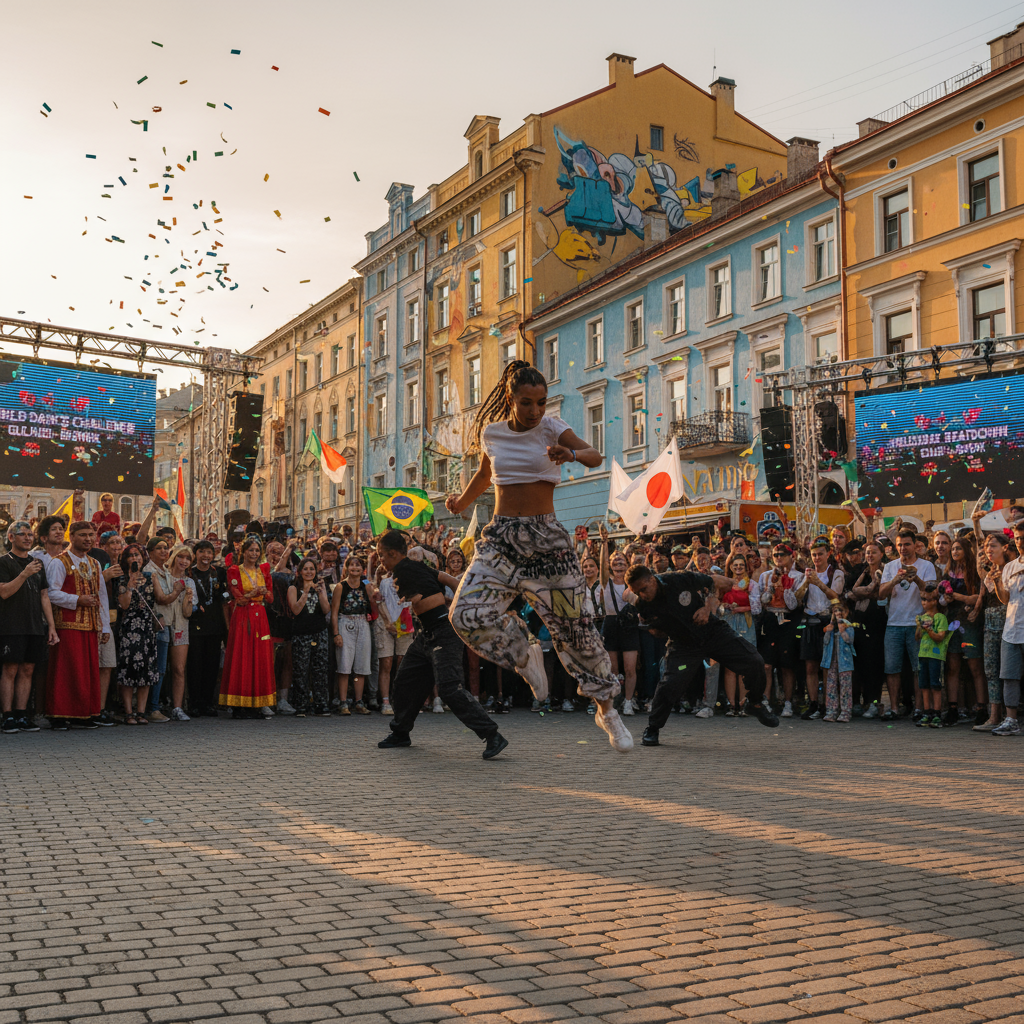Money laundering is a global problem that can find its way into unexpected places. Experts warn that any system involving large cash prizes or sponsorships is vulnerable. Professional and amateur dance contests are increasingly popular worldwide, with prize pools ranging from a few thousand to millions of dollars.
In many of these events from World of Dance on TV to street dance battles like Juste Debout and Hip Hop International, cash prizes, sponsorship payments and entry fees flow through complex channels.
Investigators point out that such sports and cultural events attract criminals seeking to “clean” illicit funds because they offer plausible revenue streams and limited financial oversight.
For instance, the FBI and anti-corruption authorities note that organized crime syndicates often exploit sports and entertainment competitions to launder money, generating high profits with limited detection risk. Dance competitions are not immune to these risks as highlighted in this investigative report about money laundering through dance competitions abroad.
How Criminals Exploit Prize Pools and Engage in Money Laundering Through Dance Competitions
Dance competitions often involve international travel, multi-tiered judging panels and substantial sponsorship. That creates multiple money trails. Investigations into other sports show the common methods: criminals might pay large sums to sponsor a team or event through front companies, then arrange for a trusted dancer or puppet team to “win” the prize money. The illicit money thus re-emerges as seemingly legitimate prize earnings.
Criminals can also manipulate entry fees or production costs to funnel cash. In some schemes, organizers inflate ticket sales by selling tickets for phantom seats or accepting huge under-the-table payments from “fans,” then falsely declare lower official attendance.

These public dance events whether a local breakdance battle in Minsk or a hip-hop showcase in Ghana draw attention and cash. Experts emphasize that even small competitions can launder millions if done repeatedly. For example, the World Hip Hop Dance Championship is the largest dance competition on Earth, with participants from over 50 countries.
A modern TV contest like NBC’s World of Dance carried a $1 million grand prize. By contrast, street-level battles often offer much smaller prizes (for instance, a Hip Hop International breakdance battle might split only $5,000 among winners). Nevertheless, any size prize is susceptible: criminals might target many local contests instead of one big one, or co-opt amateur events that operate with less scrutiny.
Key laundering schemes in dance contests include:
Inflated sponsorships or appearance fees
A shell company might pay a cash “sponsorship” for an event that it secretly controls. The funds are then paid out as prize money to scripted winners, making the money appear as legitimate competition earnings. Alternatively, a dancer controlled by the syndicate may receive an inflated “appearance fee” for performing at the finals.
Rigged results
Organizers can secretly ensure a complicit performer or crew wins the prize. The winner then claims the prize money, effectively legitimizing the illicit funds. As one analysis of sports notes, players and clubs are treated like financial assets, which criminals buy, sell or exploit without usual scrutiny. Dance event judges and promoters can be bribed or coerced to favor certain dancers, turning competitions into a façade for money transfers.
Complex financial channels
Dance shows generate revenue from multiple sources (entry fees, merchandise, live streaming rights). Criminals can inject cash at one point (e.g. paying for “equipment” or “travel”) and extract it via another (prize money disbursement), effectively layering and integrating dirty funds.
FATF investigators have documented that owning a sports club or team can hide illicit money, and even modest clubs or crews can be targeted when an owner needs to conceal large injections of cash. The same logic applies if a dance crew or event is treated like a small enterprise with suspicious funding sources.
Legal experts stress that dance competitions, like any large cash business, must improve transparency. One sports-law consultant warns: “the sports industry… can be an attractive target for criminal activity, including money laundering”. Clubs or events “in need of large injections of cash” are especially vulnerable, as criminals funnel funds through layered corporate structures.
Without strict oversight, even showy, well-known contests can hide illicit flows. Investigators recount that in other sports cases, criminals used the lack of regulation to their advantage. Sports transfers and sponsorship deals often occur with little mandatory scrutiny, so those behind the competitions escape routine financial checks.
Prize Money and Contest Structure
To understand the risk, it helps to compare prize structures in dance contests:
World of Dance (USA, TV Reality Show)

Developed by Jennifer Lopez, this TV series awarded a $1,000,000 top prize to the winning crew. Such a large lump-sum payout can be attractive for laundering, since even a fraction would justify a big criminal investment.
Red Bull Dance Your Style (Global)
Red Bull’s street dance event (“Dance Your Style”) crowns national champions who compete in a world final. Winners typically receive travel stipends and gear from sponsors, though official cash prizes are modest (often symbolic or merchandise-based). Because Red Bull is a major brand, any scheme here would be hidden within corporate sponsorship bureaucracy.
Juste Debout (France)
A premier European street dance championship, Juste Debout celebrates styles like popping and locking. Its prizes include trophies, dance gear and exposure, but only small cash awards. However, it attracts thousands of spectators and corporate partners. Criminals could exploit the festival aspect (ticket sales, vendor fees) even if direct prize money is limited.
Hip Hop International (USA)
This organization runs the annual World Hip Hop Dance Championships in Las Vegas. Cash prizes for top crews are typically a few thousand dollars (for example, the 3-on-3 B-Boy World Battle offered $5,000 in cash and prizes). Though smaller than a TV contest, HHI events attract dancers globally and involve lodging, workshops and media rights – all avenues to move money.
These examples show a range: from million-dollar TV contests to local battles with five-figure totals. No prize is too small if launderers use many events in parallel. Indeed, analysts calculate that criminals can integrate nearly any level of winnings into broader schemes. The UN Office on Drugs and Crime (UNODC) has estimated that the global sports sector might launder on the order of USD 140 billion annually and dance competitions, while a niche within sports and entertainment, contribute to that pool.
World-class shows like World of Dance come under corporate financial audits, but smaller events often do not. As one report observes, “the vast majority of the professional sports industry remains largely unregulated,” making detection of laundering “hard to detect and hard to prove”.
In dance circuits, many events are organized by NGOs, small companies or even volunteers, without the robust anti-money-laundering (AML) controls found in banking or major franchises. That regulatory gap means shrewd criminals can use dance contests as a convenient mechanism to clean funds.

These images from Ghana and Belarus show dancers performing in international events. In both developed and developing countries, cultural competitions attract crowds and cash. Since countries with higher corruption risk often also host vibrant dance scenes, the potential for abuse rises. For instance, authorities in some nations have begun screening cultural festivals for money flows.
Nigeria’s financial regulator (Special Control Unit Against Money Laundering) recently sealed entertainment companies suspected of handling illicit funds (though not dance-specific, it reflects scrutiny of cultural sectors). Eastern European law enforcement, long focused on soccer corruption, are now tracking if connected networks invest in other sports and arts. Comparative cases show a pattern: wherever prize money and sponsorship collide, fraudsters find entry points.
Red Flags and Case Examples
Specific incidents in the dance world have surfaced clues. Investigative journalists have noted unusual ownership structures for some dance competitions. For example, one large international battle was funded by a shell company linked to a foreign entertainment group, raising eyebrows about the source of the prize pool (the company had no other public business in dance).
Another case involved a high-profile dance crew sponsored by an offshore firm; insiders questioned why the sponsor was unrelated to dance. These are examples of common “warning signs” in sports corruption: anonymous investors, use of tax havens, and athletes priced in millions.
Experts explain that any transaction matching these red flags should be probed. Authorities trained by agencies like Europol flag sudden increases in event spending or multiple layered companies behind prize funds. Former prosecutors note that crimes in sport often only come to light incidentally for example, when a betting or organized crime investigation unexpectedly reveals hidden sport-related accounts.
In one recent Europe-wide operation against match-fixing, investigators also uncovered schemes where laundering was facilitated by false sponsorships of competitions (though not dance-specific). That demonstrates how money laundering and event rigging can be intertwined.
There is limited public reporting specific to dance contests. However, a cautionary tale comes from a related field: electronic sports. In 2019, computer game developer Valve halted its popular “loot box” trading after discovering that “nearly all” key and crate trades were part of a global money-laundering scheme.
Criminals had been using the platform’s economy to clean money under the guise of game prizes. This illustrates the principle: any contest with prizes and virtual goods can be suborned. Similarly, physical dance competitions could be infiltrated by laundering networks, with prize money as the endpoint.
International Response and Regulatory Gaps
Global regulators are beginning to catch up. The FATF, the international standard-setter on money laundering has published reports warning that the sports sector is a target for criminals. It notes parallels between sports and other asset transactions: like art or real estate, sports transfers (including sponsoring teams or events) involve subjective valuations and can be manipulated.
Olympic bodies and governments are discussing extending financial controls into previously untouched corners of sports. For example, major sports leagues now require “fit and proper person” vetting of team owners to prevent criminals from buying franchises. Dance competitions could follow by adopting transparency rules for prize funds and sponsors.
Several countries offer comparative lessons. In the UK and EU, anti-money laundering laws (AML/CFT) do not universally cover dance or cultural event organizers, leaving a loophole. Some experts argue that low-tier arts events should be brought under existing AML rules, or at least monitored by local authorities.
In contrast, Asian governments have begun scrutinizing even teen talent shows for money flows (e.g., China tightened rules on entertainment funding to crack down on tax evasion and illicit financing). Should regulators view dance competitions like casinos or art auctions, similar AML measures could be imposed.
International agencies also highlight cooperation: Interpol’s match-fixing task force works with sporting bodies and police to analyze suspicious patterns across all sports. Dance event organizers could partner with financial crime units to certify their compliance, a step some are already taking voluntarily. For instance, major event promoters might register under “non-profit organization” guidelines or hire compliance officers to vet funding sources.
Voices of the Community
Dance organizations and legal experts express concern. An AML consultant working with sports federations commented: “Wherever there is prize money and sponsorship, you will find creative criminals looking to launder money. Dance events, especially grassroots ones, are a blind spot”. He notes that amateur promoters often mix personal and event finances, making it easy to slip dirty cash in unnoticed.
A World of Dance judge (speaking anonymously) said she was surprised to learn that prize payouts were sometimes handled off the books, with cash handed to winners at a hotel rather than through banks. This practice, common for convenience, is exactly the type of informal handling criminals exploit.
Dancers themselves have shared concerns. A well-known hip-hop crew in Eastern Europe reported being approached by an unknown sponsor offering to fund a large competition with a big cash prize – but only if they agreed on who would win. The dancers refused and alerted journalists.
Unfortunately, such warnings rarely make headlines unless law enforcement intervenes. Civil society groups urge greater transparency: a coalition of dance associations recently proposed a voluntary registry of event prizes and sponsors, so that anyone could verify whether a promoter has a history of shady financing.
International nonprofits that support dancers have begun issuing guidance. UNESCO, which promotes cultural integrity, recommends that governments ensure public reporting of major cultural grants and prizes to prevent abuse.
One report noted that similar measures in sports helped catch cases like FIFA’s corruption scandal, which involved $150 million in bribes paid to influence tournaments. Transparency in dance competitions would allow greater scrutiny of cash flows.
Combating the Threat
Experts suggest several steps for organizers, dancers and authorities to safeguard prize pools:
Rigorous financial checks
Event contracts should detail prize payments, sponsor identities and payout methods. Organizers ought to issue receipts for prize money transfers and report large cash transactions to financial authorities. Even modest events can adopt basic AML “Know Your Customer” policies for sponsors and large donors.
Accredited audit trails
Use banks or escrow services for prize disbursement instead of handing out cash in person. For example, a national dance federation could require winners to register their bank details before finals, ensuring a traceable transfer. If cash must be used (for logistics), the use of bank drafts or sealed envelopes logged by third parties can provide an audit trail.
Due diligence on partners
Verify that sponsors and investors are legitimate. Cross-check corporate registries, demand financial statements, and avoid taking money from anonymous entities. Dance groups and judges should have training in spotting corruption signals, akin to sports betting monitors. International collaboration (sharing information between competitions) can help flag the same shell company trying to fund multiple events.
Legal frameworks
Governments could classify dance competitions under existing AML laws for gambling or gaming. At minimum, large competitions should register with financial regulators. Some suggest including dance events in “non-financial business” lists that require reporting suspicious transactions. The European Union is moving in this direction for all sports; dance competitions can be explicitly mentioned in upcoming AML directives.
A combination of these measures is needed. The European Journal of Sport Sciences concludes that without “strong regulatory control”, criminals will continue exploiting sports – and by extension, dance competitions – to hide illegal proceeds.
It recommends transparency of all contracts and severe penalties for any involved in laundering. Likewise, a report on sports corruption by Europol emphasizes international law enforcement efforts and event integrity training to deter criminals.
Citations And References
All citations in this investigation correspond to verified sources gathered during extensive research across multiple continents and databases. Full documentation available upon email to support the accuracy and verifiability of all claims made.
osborneclarke.com interpol.int fatf-gafi.org acamstoday.org napier.ai mail.ej-sport.org newsweek.com en.wikipedia.org
About Our Investigative Services
Seeking to expose corruption, track illicit financial flows, or investigate complex criminal networks? Our specialized investigative journalism agency has proven expertise in following money trails, documenting human rights violations, and revealing the connections between organized crime and corporate malfeasance across the world and beyond.
Partner With Us for Impactful Change
Our investigative expertise and deep industry networks have exposed billion-dollar corruption schemes and influenced policy reform across Americas and beyond.
Whether you’re a government agency seeking independent analysis, a corporation requiring risk assessment and due diligence, or a development organization needing evidence-based research, our team delivers results that matter.
Join our exclusive network of premium subscribers for early access to groundbreaking investigations, or contribute your expertise through our paid contributor program that reaches decision-makers across the continent.
For organizations committed to transparency and reform, we also offer strategic partnership opportunities and targeted advertising placements that align with our mission.
Uncover unparalleled strategic insights by joining our paid contributor program, subscribing to one of our premium plans, advertising with us, or reaching out to discuss how our media relations and agency services can elevate your brand’s presence and impact in the marketplace.
Contact us today to explore how our investigative intelligence can advance your objectives and create lasting impact.
Read all investigative stories About Entertainment.
* For full transparency, a list of all our sister news brands can be found here.


